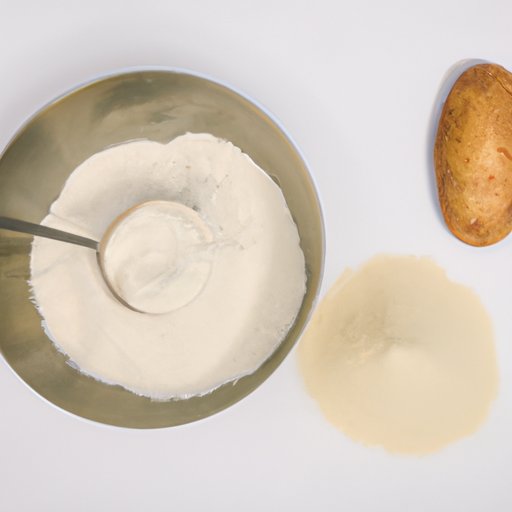
Introduction
The popularity of gluten-free diets has been on the rise in recent years. For people with gluten intolerance, avoiding gluten in their daily diet is essential. However, it can be challenging to find gluten-free substitutes for popular foods, including baked goods. In this article, we will explore whether or not potato flour is gluten-free and offer tips and insights on using it in gluten-free baking.
Everything You Need to Know About Potato Flour: Is it Gluten-Free?
Potato flour is made by grinding dehydrated potatoes into a fine powder. It has a slightly sweet taste and a light texture, making it an ideal ingredient for baking. Potato flour is also a good source of fiber, protein, and vitamins B and C.
So, is potato flour gluten-free? The answer is yes. Potato flour is naturally gluten-free, and it’s suitable for anyone looking to avoid gluten in their diet. However, it’s essential to check the packaging carefully, as some brands may have been produced in facilities that also process wheat or other gluten-containing ingredients.
There are several health benefits associated with using potato flour. For one, potato flour contains resistant starch, which has been shown to improve digestive health and reduce inflammation in the body. Additionally, replacing wheat flour with potato flour can lower the glycemic index of your baked goods, making them a healthier option for people with diabetes or those looking to maintain healthy blood sugar levels.
A Guide to Gluten-Free Baking: Using Potato Flour as a Substitute
Using potato flour in place of wheat flour can yield delicious results in gluten-free baked goods. However, there are a few things to keep in mind when substituting potato flour for wheat flour.
Firstly, potato flour absorbs more liquid than wheat flour, so you may need to adjust the amount of liquid in your recipe. Secondly, potato flour is more dense than wheat flour, so it’s essential to combine it with other gluten-free flours, such as rice flour or almond flour, for lighter texture and more stability.
Here are some recipe ideas to get you started with using potato flour in gluten-free baking:
- Potato Flour Chocolate Cake – Replace wheat flour with potato flour in your favorite chocolate cake recipe for a dense, fudgy texture.
- Potato Flour Pizza Crust – Mix potato flour with other gluten-free flours to make a crispy pizza crust that won’t crumble.
- Potato Flour Chocolate Chip Cookies – Add potato flour to your cookie dough for a chewy, dense texture.
When adapting existing recipes, try using a blend of 60% gluten-free flour and 40% potato flour.
How to Determine if Potato Flour is Gluten-Free
To ensure that your potato flour is gluten-free, it’s essential to read the packaging carefully. Look for a label indicating that the flour is gluten-free or has been produced in a gluten-free facility. Additionally, check the ingredient list for any potential allergens, such as wheat or barley.
If you’re still unsure, research the manufacturer’s practices online and see if they have been certified by any gluten-free organizations.
Potato Flour vs. Other Gluten-Free Flours: What You Need to Know
While potato flour is an excellent gluten-free flour, there are other options available as well. Here’s a comparison:
- Almond flour – Almond flour is an excellent choice for dense baked goods like cakes and muffins. It’s higher in protein and healthy fats than potato flour, making it an ideal choice for anyone looking to boost their nutrient intake.
- Coconut flour – Coconut flour is a naturally gluten-free option that’s high in fiber and low in carbohydrates. It tends to be denser than potato flour, so it’s best suited for recipes that require less fluffiness, such as brownies or pancakes.
- Rice flour – Rice flour is a light, fluffy flour that works well in combination with potato flour. It’s neutral-tasting and is ideal for recipes that call for a lighter texture, such as cakes or bread.
The choice of flour ultimately depends on the type of baked good you’re making and your personal preferences.
Expert Tips for Using Potato Flour in a Gluten-Free Diet
Here are some expert tips on using potato flour in your gluten-free diet:
- Balance your nutrient intake – While potato flour can be an excellent addition to your gluten-free diet, it’s still crucial to ensure that you’re getting a balanced intake of nutrients. Make sure to include a variety of other gluten-free flours in your diet, as well as fresh fruits and vegetables.
- Experiment with recipes – Don’t be afraid to experiment with different recipes and flour combinations when using potato flour. Trial and error is the best way to find what works best for you.
- Store potato flour properly – Keep potato flour in an airtight container in a cool, dry place to preserve its freshness and prevent it from absorbing moisture.
Conclusion
Potato flour is an excellent addition to any gluten-free diet, providing a high nutrient value and yielding delicious results in baked goods. By following the tips and advice outlined in this article, you can easily incorporate potato flour into your gluten-free diet and enjoy all the benefits it has to offer.
Share your tips, successes, and challenges with others in the gluten-free community and encourage others to experiment with potato flour in their baking.





